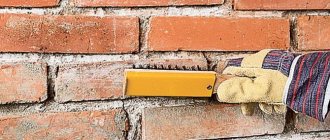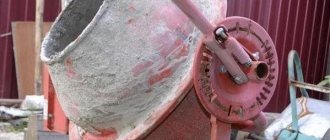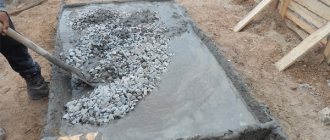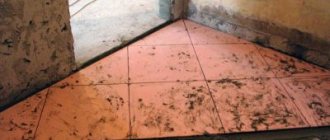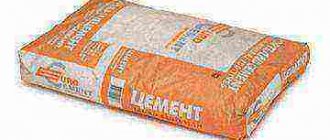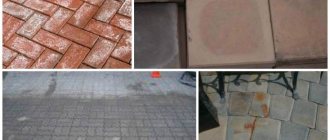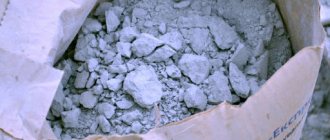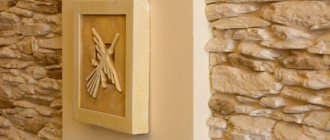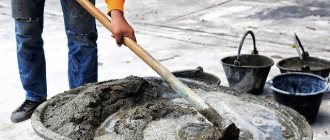Washing off cement is a labor-intensive and troublesome task. The complexity of this process is determined not so much by the volume of work as by the specifics of the material itself: hardened cement firmly eats into the surface of anything. The article discusses the main options for solving this problem.
Let’s immediately make a reservation that we will “fight” cement stains in thick clothing, if possible covering all usually open areas of the body, and in rubber gloves. This precaution will protect the skin from the active ingredients of the solvents that are used to remove cement. So, the main construction work using cement mortar is completed, and the most interesting part begins - putting things in order. Strokes that have not yet hardened and drops of cement that have not had time to set can be scraped off with a spatula with very little effort. If you missed this “lucky” moment, get ready to tinker a lot.
Removing cement from tiles
If you have the idea of dealing with dirt using a nail, hammer or chisel, immediately discard it - such a “barbaric” method will be justified only in cases where the surface being cleaned is not of particular value.
Tiles are a delicate material; ideally, all unnecessary traces of the construction process should be removed from its surface immediately. You need to work with frozen mortar residues carefully so as not to scratch the work surface.
- First, try removing the cement using improvised means. Generously moisten a piece of cloth folded in several layers or a small thick sponge with a toilet remover. Place this “compress” on the problem area and leave it there for several days. Remember to re-saturate the fabric with cleaner when it dries. Alternatively, you can treat the stain with a hydrochloric solution (5% hydrochloric acid) and rub it with an abrasive sponge. If the contamination is relatively fresh, it can be removed.
- To clean the tiles from cement drops that have not yet completely set, ordinary salt is also used. It is applied directly to the site of contamination, previously moistened with cold water. After some time, when the stain acquires a loose consistency under the influence of salt, it can be carefully cleaned off with a stiff brush.
- To remove old marks, you will have to buy a special cement mortar solvent, stock up on a spatula, a container with clean water, sponges and rags. Also suitable for these purposes are special cleaning agents for ceramic surfaces (for example, Sopro ZEA 703 solvent) or dried glue solvent. Before you start working, carefully study the information on the packaging of the purchased product: many solvents contain hydrochloric or phosphoric acid as an active ingredient; they cannot be applied to some materials. Treat the tiled surface with the special product with extreme caution, because there is a risk of dissolving the necessary grout joints along with unnecessary stains.
- If you have a soft brush on hand for a drill or grinder, be sure to try removing dirt using these tools. When cleaning tiles, they should work at minimum speed.
Concrete cleaning agent CEMMIX CemClean
CEMMIX technologies and materials make it possible to effectively and easily clean and protect the surfaces of concrete and stone structures, both at industrial facilities and in domestic conditions. Surface cleaning with CEMMIX CemClean is quick and effective.
The consumption of the cleaning agent largely depends on the contamination, porosity and absorbency of the surface to be treated and is approximately:
for large solution residues, the product is diluted with water in a ratio of 1:1, consumption 50-100 ml/m2
old efflorescence, dirt (traces of solution), the product is diluted with water in a ratio of 1:3, consumption 400-500 ml/m
limescale, traces of rust, the product is diluted with water in a ratio of 1:5, consumption 200-300 ml/m2
Removing cement from glass
Cleaning cement from glass and decorative surfaces requires a container of water, washcloths and rags, a blade, a scraper, a special brush for washing windows, a chisel, vinegar and a remover for cement residues.
- To begin, blot off cement stains with a sponge soaked in hot water. After one or two minutes, thoroughly rub the wetted areas with a rag, and then arm yourself with suitable tools. This could be a scraper for cleaning hobs. Afterwards, use a special brush to clean the windows.
- Try gently scraping off any dry cement beads with a razor blade. Take your time, your goal is not to scratch the surface of the glass. To do this, do not scrape off the cement with the sharp corner of the blade; work only with its side cutting plane. Then wash the surface with plenty of clean water.
- There is another popular method of dealing with cement marks on the surface of glass - cleaning with table vinegar. Apply acid to the required areas of the surface and, as the cement mass softens, clean it off with a brush.
Removing cement from paving stones
First of all, prepare the tools you cannot do without. Contaminants from the surface of the paving stones are removed with a hammer, a stone chisel, a wire brush, sand, sandpaper, a cleaning agent based on phosphoric and hydrochloric acids, garden lime or baking soda, ammonia and water.
- Try removing cement residue from paving slabs using a hammer and chisel. You need to pick up the cement, but if it doesn’t work, all is not lost - lightly tap the center of the dirt with a chisel; as a result of such manipulation, its top may crack and detach from the surface of the paving stones. But don’t be too zealous if the stain is firmly ingrained into the tile, as you will only damage it. Using a wire brush in different directions, remove as much of the remaining stain as possible. Again, try to remove the stain from the pavers with the chisel. Alternate tools several times in a row. Another way to test the surface is to sand it with sandpaper or a sander. This way you will level the cement contamination with the stone level of the paving slabs.
- If the mechanical method of cleaning paving stones from contamination is not successful, use a chemical cement remover with phosphoric acid. The modern range of chemicals for combating cement residues is very large: Rubinet, Barracuda, Metalin OF-C, ECOSEPT 210 and others. Just don’t forget to make sure that the “chemistry” won’t significantly damage the paving stones by testing the product on a small, inconspicuous area. Before applying, neutralize excess phosphoric acid with garden lime (you can take a little baking soda for the same purpose, ammonia will also work). The solution should lift the stain away from the tile; the remaining residue can be removed with a brush at the end of the procedure.
- In terms of the strength of the chemical reaction, hydrochloric acid is superior to phosphoric acid, so if the latter does not cope with the task, treat the stains with a product based on hydrochloric acid. Before application, it must be diluted with water in the volume specified by the manufacturer on the packaging. Do not rinse the product off the tiles until it dries, then remove the dirt with a brush.
Note!
- It is rare that a chemical cleaner will leave the color of the paving stones in their original condition. To keep “losses” to a minimum, apply the cleaning solution exactly to the place of contamination, not allowing it to get on the clean surface.
- If the paving stones were covered with sealant, after applying the “chemistry”, treat its pre-dried surface with sealant again. This way you can return the tiled surface to its “native” color.
- Acids are not used in concentrated form - they are always diluted with water. After using an acid-based cleaner, the surface of the tile is treated with a neutralizer and washed with clean water.
Method 1 – non-liquid chemicals
- If the pollution is not particularly strong, then before using expensive products, you should try the following options. Hardware stores sell special wipes for cleaning glass. You can buy a couple of them and try to remove stains with them. To avoid scratches, do not use hard sponges or cleaners with abrasive particles. These wipes are mainly suitable for stains that have recently appeared.
- Baking soda is perhaps a universal solution for cleaning anything. There is soda in every kitchen. With it you can remove old and even stubborn stains. Baking soda is an environmentally friendly product. Essentially, baking soda is an alkali. For the best effect, you need to mix soda and vinegar in equal proportions. But some people think that vinegar (acid) neutralizes soda (alkali) and there is no effect. Therefore, first try moistening the stains with vinegar, wait 30 minutes and then add baking soda to the stains.
- If you don't have baking soda, you can try using toothpaste. But there is one caveat. You need to use regular white toothpaste, not tooth gel. Apply the paste to a towel and rub it onto the stain using circular motions. After 5 minutes, mix water and vinegar in equal parts and rinse off the paste with this solution.
Removing cement from brick (brick wall)
Cleaning brick from cement is a pressing issue. An old brick from dismantled masonry, stained with cement blots, can still be useful - the main thing is to give it a “marketable” appearance. A freshly built brick wall with stains or slides of cement on the surface also requires at least minimal cleaning.
Despite the visual reliability of a brick block, careless removal of cement residues can damage it. You need to act deliberately and slowly.
- The simplest way to clean brick is to use a hammer and chisel. Use these tools to carefully chip off the largest “islands” of mortar. When there is not a single large piece left, sand the surface of the brick. For convenience, knock down two wooden slats and attach sandpaper to the transverse part of the homemade tool. This way you can clean red brick, while its silicate “brother” requires more time and effort.
- To make the work go faster, arm yourself with sandpaper and a jackhammer (or, as an option, a drill with a special attachment). Be careful - while working, protect your eyes, mouth and nose with goggles and a respirator from the inevitable dust.
- Another way to deal with cement residue is to place the bricks in water. The cement mortar is mixed with water, so water will act as a solvent on its residues. Wait a while, then scrub the brick surface vigorously with a stiff brush.
- High-quality red brick can be cleaned with a sulfuric acid solution. It is diluted with water in a ratio of 1:10 or 1:7. Keep in mind that acid is very dangerous and can cause burns to the skin and mucous membrane of the respiratory tract. The brick is placed in a cast iron bath, poured with the resulting cement cleaning agent and boiled for some time over a fire. As a result of this heat treatment, the remaining cement should dissolve. Such experiments are not suitable for sand-lime brick - it will simply collapse.
- Treat finished brickwork contaminated with stains and blots of cement with any concentrated alkaline-based product from a rich arsenal of auto chemicals. Prepare a diluted cleaning solution according to the instructions, saturate a thick piece of cloth or roller with it and apply evenly to the wall. When the masonry is dry, rinse the wall with large quantities of clean water.
- Rub the brickwork with a homemade mixture consisting of sunflower oil and crumbs, which are formed when sawing bricks with a grinder. Wait for this substance to dry (it will take a long time), then use a stiff brush to scrub it off the brick.
- Ceramic bricks are cleaned with diluted hydrochloric acid. First, pour running water over the masonry, and then carefully wipe the contaminated areas with a cloth soaked in an acid solution. Make sure that the acid does not get on the masonry joints. If this happens, wash the areas where the acid begins to form as plaque with a solution of liquid soap and water.
The washing process is quite complicated, because, in addition to the fact that cement is difficult to wash off, the procedure must be carried out in special clothing that can protect the skin from the active substances of the solutions, which will dissolve the cement. The use of rubber gloves is mandatory. Below is how to choose a solvent.
Production scheme
Washing problem
During the construction process, even with the utmost diligence and care, it is possible to get cement (or other mortar) onto the finished surface, which immediately spoils the entire positive result. If you immediately remove cement or other mortar from the surface, you will be able to avoid further work on washing the surface of “flippers” made from the mortar used. But the fact is that if you bend over each time and erase the stains that have formed, then this process can increase the operating time many times over. That is why wiping off drops of mortar is done only when the construction work is completely finished. The most difficult thing is to remove stains that have already hardened and stuck to the floor or other surface. It is quite difficult to remove or wash these drops, but it is still possible.
There are several methods that actively use cement solvents and other special compounds that help remove any solutions from the working surface. The most common component of these solutions is phosphoric acid.
You can try to scrape off soft, uncured drops with a spatula, and dried residues need to be dissolved with a special solution. If the solution has managed to harden, then you will have to tinker a little longer with the resulting drops, using not only a solvent, but also other methods and methods.
Method 3 – prevention of glass surfaces
- If stains from hard water do not appear on windows, but, for example, on glass in a shower stall, then you should take care of installing special filters that will purify hard water in advance.
- Of course, this is labor-intensive, but if you promptly clean the glass after rain or after taking a shower and remove excess moisture from the glass surfaces before it dries, you will prevent hard water stains from appearing.
- Hardware stores sell special products for glass that protect them from stains. After washing the windows, you need to apply this product to the glass and then you won’t have to, in the future you will perform all the above points.
Adviсe
Contact our cleaning company for help.
If the stain was not completely removed the first time, repeat the procedure.
It is best to use sponges rather than cotton rags to clean windows.
Removing contamination
What people are willing to do to get rid of contaminants that interfere with their work. For example, when removing hardened cement, they use both nails and a hammer, trying to use these objects to destroy the hardened pieces and still tear them off the surface. Yes, this method may be effective, but it is only suitable if the surface itself does not have any value and there is no danger of damaging it. But what to do if the surface needs to be preserved and cannot be damaged in any way?
Pollution removal scheme.
For example, there are times when, after removing old tiles from a wall, we want to use them again and put them, for example, in a garage or other place. But before using the tile again, it must be cleaned of cement. In such cases (to clean the tiles), builders advise immersing the tiles in water, covering all the cement on it with water. When the cement has softened a little, you can try scraping it off with a chisel. At this moment, the correct placement of the tile is important: it must be held in a horizontal direction, pressed firmly against a flat surface.
A cleaner used instead of water can speed up the softening process. Using a cleaner will remove cement from the tiles within half an hour.
Many people use a grinder to scrape off surfaces. In this case, it is recommended to set the tool to the lowest speed, first firmly fixing the material that will be cleaned.
What should not be done when cleaning PVC windows from construction contaminants
A particularly intensive fight against the consequences of repairs can result in numerous damage to plastic surfaces. You should not approach solving problems with zeal and thoughtlessly use too aggressive chemical compounds. After all, it is very easy to damage the plastic, and then it will be impossible to correct the situation. Therefore, if you have to clean an apartment after renovation with washing PVC windows, never do the following:
- Do not apply detergents to rubber parts or seals. Their structure may be destroyed, and the tightness of the entire window as a whole will be lost;
- If traces are still not removed even after all the recommendations, you can use special specialized compounds to combat lime. The main thing here is not to neglect the instructions and strictly follow the steps described in it, prepare the compositions in the recommended proportions;
- Do not buy solvents or other products that say “not for use on plastic” on the packaging. This means that they can damage the window sill, frames, and leave marks that will subsequently lead to the destruction of surfaces. There is no need to risk the window unless absolutely necessary, since it could all end in its... replacement.
Home methods
There are many different methods for removing cement from surfaces or materials, but most often these methods require mechanical or chemical action on the hardened cement mass. Before using one of these methods, you need to make sure that the surface on which the cement remains is strong and hard, and the use of mechanical stress will not result in the appearance of cracks or chips on it.
What tools and materials may be needed:
- Chemical solutions.
- Hammer.
- Big nail.
- Putty knife.
- Solvent.
In cases where cement needs to be removed from a brick, it is better to use a chemical solution so as, firstly, not to damage the integrity of the brick itself, and secondly, not to spoil the appearance of the entire structure. In cases where there is no risk of damaging the bricks, and the frozen parts are very large, the option of using a hammer, large nails and a spatula is acceptable.
Removing cement using a solvent is a good and effective method of cleaning the surface.
It is important to remember that before removing the mortar from the surface, it is necessary to clean or fix this surface (mandatory), in cases where cement is removed from individual elements (ceramic tiles, glass, etc.).
In order to choose the right solvent and not make a mistake with your choice, you can contact a special store where consultants will help you choose a solvent (or other product) for a specific surface. It is important to take into account the fact that chemical compounds can negatively affect the surface, for example, the design may be damaged, marks, smudges or white spots may remain.
Although it is simply impossible to find a 100% safe method for removing hardened cement from tiles. After all, in any case, there remains a risk of scratching or breaking it, even if you act in the most careful way. For example, when chipping cement with a nail, you can scratch the tile simply by not calculating the impact. In cases with the use of a chemical solution, the situation is the same: the cement is rubbed off well, but the consequences are not always eliminated easily and quickly. Therefore, when selecting the right product, you should be extremely careful; it is important to think through the entire work process in order to avoid unnecessary consequences.
Extraordinary solutions
Above we looked at the options when cement got on the working surface or material that needs to be cleaned from drops of solution. But what should you do if cement gets on good clothes, stains fabric or carpet, for example? We must not forget that during work there is an option to stain absolutely any surface. Therefore, you need to figure out what and how you can dissolve cement.
What you need to prepare for work:
- Sponge.
- Tweezers (or blunt knife).
- Chemical solvent.
- Paper towels.
- Plastic film.
- Acetone.
- Isopropyl alcohol.
- Toothbrush.
- Glycerol.
- Liquid dishwashing detergent.
- Water.
- Table vinegar.
If the solution has already dried, you can try to remove dry particles from a fabric or carpet surface using tweezers or a blunt knife. You can apply chemical solutions by moistening a sponge with a small amount of solvent and applying it to the contaminated surface. A few squeezes will help solve the problem.
Using a sponge, it is necessary to treat all contaminated parts of the fabric. It is important that the solvent reaches the entire affected surface. It is advisable to move the sponge in the direction from the center of the fabric, moving towards its edge. It is advisable to use stain removers when washing in washing machines.
Many people advise adding a drop of table vinegar to the powder instead of a stain remover, which is a good way to remove stains.
You can moisten a sponge with alcohol or acetone, place it on the stain, and cover it with plastic film to reduce the evaporation of the solvent. This method works well to remove dry cement from surfaces such as ceramics, acrylic or glass. A sponge moistened with alcohol or acetone should be kept on the surface for an hour, after which the sponge is removed and the cement is cleaned with a damp cloth.
Mixing a quarter cup of glycerin, dish detergent (also a quarter cup), and two cups of water makes a good all-purpose solution to help clean (or launder) cement-damaged surfaces. All ingredients must be mixed in a bottle to make it easier to apply the product to the surface of the material. The composition is applied to the surface and rubbed in with a toothbrush in a circular motion. The method helps to remove residual cement from any surface.
Many construction works today use acid cement solvent
. It allows you to easily remove dried material without damaging the surface. We will talk about how to use it and its varieties in the article.
Why is cleaning cement so difficult?
A universal material used in many construction works. It is used both when laying walls and foundations, and when decorating various interior materials. However, during the work process the mixture may inadvertently get onto other surfaces. And if you don’t have time to wash it off before the cement dries, it will be difficult to remove it.
The process will be especially aggravated if the stained surface is the most visible and is made, for example, of ceramics, glass or mirror. Then it will be impossible to use mechanical methods to remove cement and will have to use chemicals.
Plus, it can harden on various tools (brushes, brushes) and equipment (concrete mixer, mixer attachment). And if spatulas and brushes can be easily replaced with new ones, then the equipment will have to be scrubbed for its further normal operation.
How and with what to wash cement?
How to clean cement from tiles
or any instrument is a question that worries many. But before we determine the method, let's analyze the mixture. Is it still liquid or already hard and strong? If it has not completely dried and is in a viscous state, then a mechanical cleaning method in this case will be very useful. That is, you can scrape off the composition with a knife or small spatula (when the surface is not decorative). But if the cement has already hardened, then the mechanical method can be harmful. And when you have ceramics, a mirror or glass in front of you, then you shouldn’t use it at all.
In such cases, a special chemical cement remover is suitable. It allows you to eliminate any hardened stains in the shortest possible time and without unnecessary problems. It is only important to use it in accordance with the instructions. As a rule, the surface is first cleaned of dust. Next, apply the cement solvent using a brush or roller. In some cases, for large volumes of work, a spray bottle is used. And remember that it is important to protect your eyes and hands from the mixture during the process. Wear rubber gloves.
If we talk about specific manufacturers, Himfrez and Lugato are considered the best. Chemical freze is used for many decorative coatings, as it allows you to preserve the design; it has very good characteristics:
- Environmentally friendly composition, does not contain hydrochloric and orthophosphoric acid;
- does not have a harmful effect on nature and humans;
- has no specific odor.
Lugato is an acidic cement cleaner. Therefore, it should not be used on acid-resistant coatings. For example, it is highly undesirable to use it for marble or terrazzo.
When using either product, it is important to follow all recommendations on the packaging. First, ventilate the room properly. We remember that the compositions used are chemical, so the components released into the air can irritate the nasal mucosa. Secondly, the temperature in the building must be more than +5° C. Thirdly, upon completion of work, the composition must be stored in a dark place. The packaging must be properly closed.
There are many more chemical mixtures on the market (ECOSEPT 210, Rubinet, Barracuda and a number of others). You can find out about them in any construction supermarket.
How to remove cement from working equipment?
In addition to cement getting on clean surfaces, there is another problem. Often the mixture hardens on the working equipment. And in this case, the problem arises - how to dissolve the cement? Can I use the same liquids or do I need something different? As it turned out, the equipment has its own proven remedy, which has a name - Bio Decap'Beton Guard.
The composition was developed by several specialists who wanted to find an alternative to harmful acidic solvents (containing orthophosphoric, hydrochloric acid and a number of others). So, this cement remover is extremely easy to use. Just 20-30 minutes is enough - and the mixture will be removed, and your device will be like new! During application, no harmful components are released.
If you work in the construction industry, or have ever done a major renovation yourself, then you know how difficult it is to clean cement stains.
It’s not so bad to wipe it off your clothes, but what if the finish, tiles, wood or façade of the building is damaged? And regarding the question of how to wash cement from a car
it is necessary to use different methods - after all, our goal is to clean the mixture without damaging the surface. Today we will look at all the recommended methods.
What not to do when cleaning cement
In order not to spoil the materials, you should never use the following solutions and items:
- Blades and knives, sandpaper, especially if you are going to remove a stain from a car or window.
- Citric acid, vinegar and soda are the enemies of any coating. They discolor and scratch surfaces, removing cement mortar unevenly.
- Never clean hardened cement mortar using the dry method - scratching, picking with a knife or chisel, or rubbing with a metal sponge.
- If scratches appear, treat the surface with polish.
Unfortunately, even today, aggressive agents are actively used to clean cement. Now we will tell you more about them.
How to clean cement from tiles - instructions for action
So, in order to clean cement from tiles, sometimes it is enough just to rinse it with plenty of water. But if there are large contaminated areas, or the cement has hardened, then professional chemistry is used.
During installation and drying, fungus may form between the tiles. Then the question arises: how to clean paving slabs
from cement and mold? If there are no chemicals at hand, chlorine copes well with this task. Dilute it in plenty of water and apply to the fungus-affected area. Wait 5 - 10 minutes, then rinse the solution with water.
The disadvantages of this method are an unpleasant odor, harmful fumes, and a white coating will remain on the tiles.
How to wash cement - universal cleaning methods
The most common methods of cleaning surfaces from cement, unfortunately, are not always gentle. So, for example, to remove cement from a car, it is suggested to wipe off the dried mortar with sandpaper, and then polish the damaged paint. The method, with a stretch, can be called effective, but the appearance of your car will be ruined.
In order to clean windows from cement, it is suggested to simply dissolve the mixture with warm water. For difficult stains the following materials are used:
- Lemon, lemon juice.
- Vinegar.
- Soda.
- Ammonia.
- Household chemicals, meaning sprays for polishing, cleaning from dust and grease.
- Chemicals for cleaning stains that appear during repairs are ATC 350, Barracuda 10k, Atlas Szop.
It is most reasonable to use chemicals that contain several types of acids that affect the structure of hardened cement and penetrate deep into the largest stains.
When using chemicals, do not forget to take care of your safety - wear gloves and a respirator. Of course, the funds are safe, everyone has a certificate of state registration
in the Russian Federation, they comply with modern standards, but acid is acid, and safety rules should not be neglected.
One of the best among the listed chemicals, judging by the reviews, is ATC 350 made in Belgium
. Let's look at it in more detail.
Nerta - remove cement in 20 minutes without hassle
Let's start with the fact that Nerta chemistry is biodegradable and does not emit harmful fumes. And, therefore, it can be used for washing cement in public places, institutions for children, cafes, restaurants and apartments.
In order to clean cement stains from facades, tiles, sidewalks, cars or glass, we need a brush, gloves and protective clothing. Using a brush, apply the solution to the stain, wait for 10 to 20 minutes, depending on the complexity of the stain, and wash off with plenty of water. You can also use a sponge to wash off the mixture by hand. It is worth noting that the cement comes off without problems, but if you see that some particles have not been washed off, simply repeat the procedure, applying for 5 - 10 minutes. The composition is liquid, it does not contain absorbent substances that, for example, will damage the paint on the body of a new car or scratch the glass.
The cleaning capabilities of ATC 350 are universal. It also works well against concrete, lime, rust and even mold, which often occurs during renovations due to high humidity. Methods of application for removing these construction stains are described in detail in the instructions.
Effect of ATC 350 on materials
Before you start cleaning, be sure to check how Nerta behaves on the material being washed. The fact is that low-quality materials can fade. Apply the product to a small area and leave it for 5 minutes, after washing off, usually nothing terrible happens, you will see the coating cleared of cement.
Why is chemistry better than old cleaning methods?
If you don’t know how to clean cement from tiles
, then be sure to try ATC 350. When laying tiles, wall or paving, gaps and cracks appear into which cement penetrates. It is impossible to wipe them off manually, and the chemicals penetrate deep into them, dissolving the remains of hardened cement.
During construction work, it is very difficult to lay tiles, level slopes and make screeds, simultaneously rubbing in dropped or smeared cement. That is why the mixture is almost always washed dry. You will spend too much time on manual cleaning and risk damaging expensive finishes or double-glazed windows.
The second advantage of Nerta
– speed and ease of cleaning.
Speaking of how to clean windows from cement
, old methods recommend rubbing the stains with lemon halves or lemon juice. Just imagine how much time this will take, and then you will have to wipe off the stains from the glass.
Lemons, vinegar, soda are a thing of the past that can be used for small stains that appear during minor work. During construction, professionals prefer to clean stains from concrete, cement, rust, and lime using Nerta
ATC 350, because they value their time!
Processing agents
Most lubricants are suitable for column formwork made from a variety of materials, from wooden panels to polymer molds. Common preparations for processing casting molds include DEBOND FORM COATING, EZ STRIP, FORM LIFE, GAMBIT-FORM, Betopro oil and others. At the same time, DEBOND FORM COATING, EZ STRIP and GAMBIT - FORM are universal products, that is, they are suitable for use with various types of formwork (wooden, plywood, metal, polymer), FORM LIFE is designed to protect wooden and plywood formwork, and Betopro oil is aimed at use for metal mold elements.
